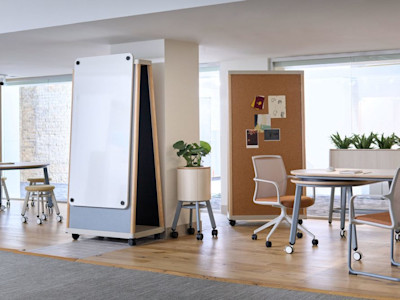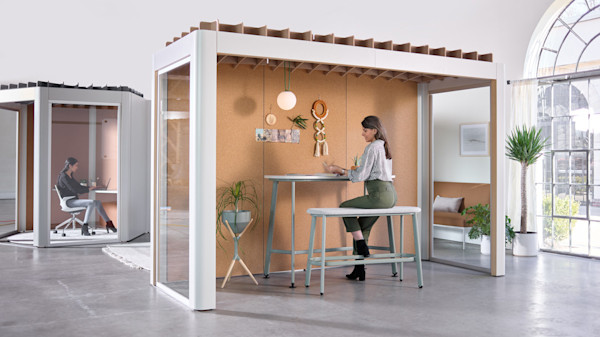What is a Hyper-Flexible Workspace?

It seems like over the last few years, the future of work is evolving at a faster pace. From the advancement of technology to innovative office designs, companies are constantly evolving. Whether these evolving changes in the future of work stem from necessity or preference, it seems like there’s some new way to approach the way we work every day. From open layouts to adaptive spaces and flex spaces, employees are utilizing every resource that their companies provide them with. However, a new concept in office design is here – the hyper-flexible workspace.
When it comes to the evolution of the office, we’ve come a long way. There have been many changes and many driving factors. Over the years, we’ve endured utilitarian cubicle-lined offices, offices that hinder employee wellbeing rather than promote it, and spaces that are very inefficient. Whatever the reason for these much-needed changes in office design, companies are at the point where they can optimize existing concepts and fine-tune their designs to fit employee needs.
What’s the Difference Between a Flexible and a Hyper-Flexible Workspace?

Design a highly functional hyper-flexible workspace
The term “flexible” in the office has been used a lot over the years. However, the hybrid business model has propelled us into a world where – out of necessity – the office has been reimagined. Some companies no longer hold traditional hours, and others need less space. This has made companies change their approach to office design to become more efficient and productive.
The flexible workspace gives employees a space to easily shift tasks and modalities seamlessly. Without an office structure that you might find in a more traditional office, the office needs to be designed to meet specific needs. This often varies depending on the scope of work. But in the office, hyper-flexible doesn’t just mean the design or layout. It also means the freedoms and flexibility that employees are granted. To some degree, a hyper-flexible model allows employees to work the way they want.
Allwork recently showcased a company that employs the hyper-flexible work model. The Allen Institute in Seattle has put a major emphasis on employees’ personal needs. Because of this, they have created a working environment that allows employees to build custom schedules, a personalized work-life balance, and minimal in-person days to help foster a sense of teamwork and collaboration. The future of the hyper-flexible model is leaving its mark on the future of work.
How to Build Your Hyper-Flexible Space
The hyper-flexible work environment that the Allen Institute has created doesn’t necessarily to bringing in elements of the office design that go with it. Building these hyper-flexible spaces gives employees the ability to work efficiently while improving productivity. But how exactly do you prepare for building a hyper-flexible environment?
To create an efficient and productive office environment, identifying and satisfying employee needs is key. Designing an office efficiently is just as important as employees working efficiently. While you can build the office you want, it might not be what you need. Take into account your company’s model. The physical office space. Understand what it is your employees need to perform at the level they can.
What Goes into a Hyper-Flexible Space?

Learn how to include elements of the hyper-flexible model in your office
There are several elements of office design that go into creating a hyper-flexible workspace. However, designing a hyper-flexible space doesn’t mean you need to incorporate every element and check all of the boxes. It means incorporating the elements that you need. Let’s look at the 4 main elements of a hyper-flexible space:
Flexible Spaces
Flexible spaces or flex spaces provide employees with the ability to use a space in different ways. This includes modular workstations or spaces that can easily be arranged for collaboration. Flexible spaces are the cornerstone of the hyper-flexible office. This is especially true for offices with limited space or companies that are concerned with minimizing their footprint.
Adaptive Spaces
The concept of an adaptive space is similar to what a flexible space achieves. It creates a highly functional workspace. However, an adaptive space is designed to create a very specialized workspace unique to employee needs. Adaptive spaces use mobile and movable furniture so employees have the ability to move about the office into different work zones. This includes mobile storage units, movable partitions, and modular workstations.
Employee Well-Being
Well-being is something that has become a focus in office design. Whether it’s mental or physical well-being, happy employees are productive employees. A study from Psicosmart discusses the connection between employee well-being and productivity. From wellness initiatives to enhancing well-being, the benefits of fostering wellness are obvious.
In a setting that often has limited structure, focusing on wellness is important. However, when employees are able to create a personalized or custom work experience, the personalization shouldn’t stop at the way they work.
Technology
Almost all changes in modern office design have been driven by technology. Because of this, tech-integrated furniture, automated tasks, and employee monitoring have all become a part of the office we know today. The introduction of constantly evolving technology makes highly functional offices possible.
Incorporating technology that optimizes collaboration, productivity, and flexibility is crucial to the hyper-flexible space and the hyper-flexible model. Therefore, tech can minimize a company’s footprint, create a more efficient space, and allow employees to work with more freedom.
Is the Hyper-Flexible Workspace Right for You?

Let us help you design a hyper-flexible office
Like all elements of office design, one solution isn’t right for everyone. However, it doesn’t hurt to consider all aspects of office design. Whether or not you should replicate an entire office or just pull elements from one, you might be surprised by what you can include in your design or revamp.
So, consider the office furniture you need. Entertain the idea of something new. Above all, give your employees the chance to personalize the way they work. StrongProject can help you design and shape your office based on your company’s needs and wants. Find out how we can make your ideas come to life.
Contact StrongProject to learn more about how we can help you design your office today!
Want to learn more about modern office design? Check out these related posts:



